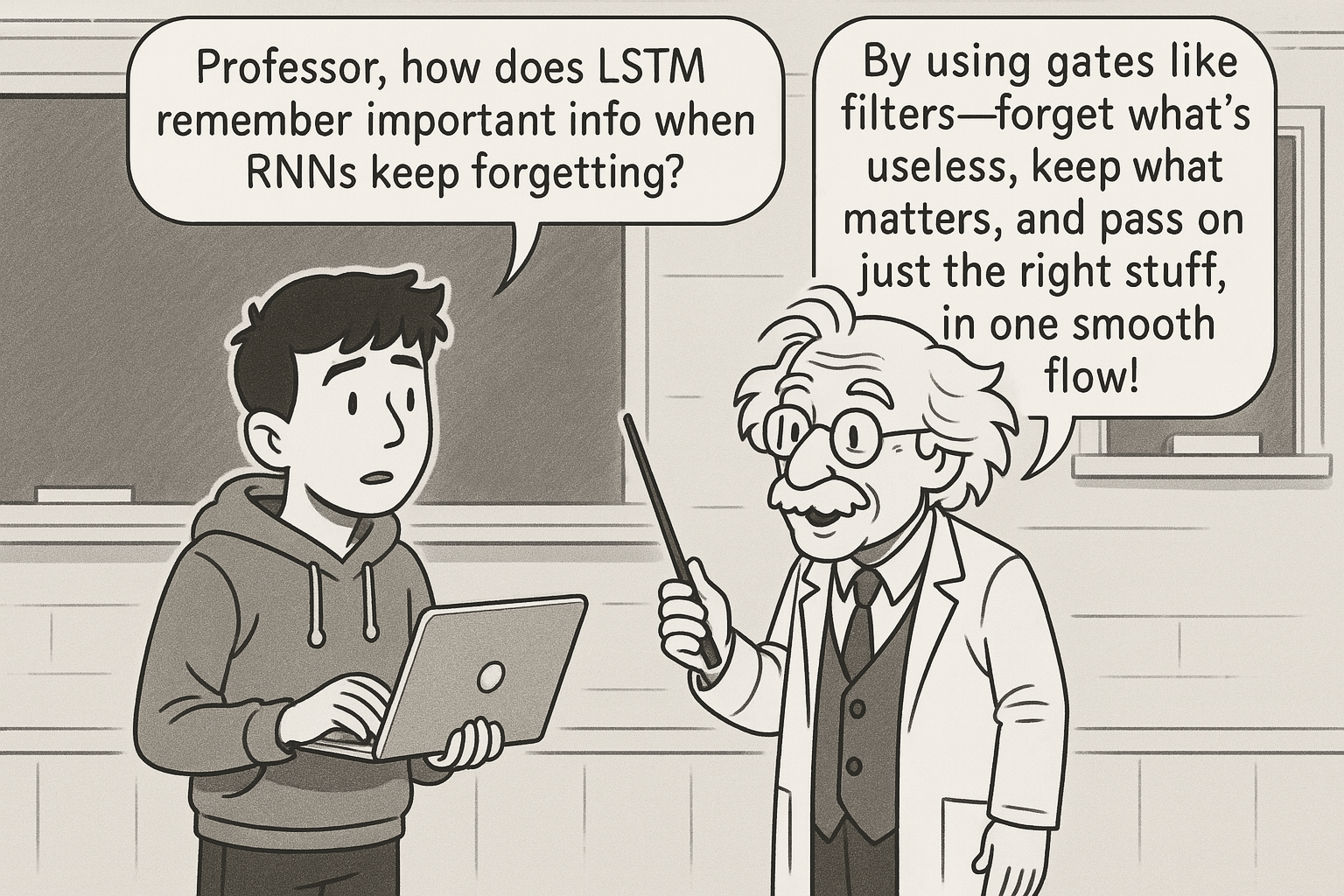Introduction
In 1997, Sepp Hochreiter and Jürgen Schmidhuber published "Long Short-Term Memory" in Neural Computation, introducing a revolutionary architecture that would dominate sequence learning for the next two decades. Their work addressed a fundamental limitation plaguing neural networks - the inability to learn from long sequences of data due to vanishing and exploding gradients. This breakthrough enabled neural networks to finally understand context and maintain memory across extended time periods, paving the way for modern speech recognition, machine translation, and natural language processing systems.
"Intelligent gates controlling information flow transformed neural networks from forgetful servants into systems with genuine memory and understanding."
Core Ideas
The heart of the LSTM (Long Short-Term Memory) innovation lies in its sophisticated gating mechanism that controls information flow through the network. Unlike traditional recurrent neural networks that struggle to remember information from many time steps ago, LSTMs introduced three specialised gates that act as intelligent filters for information.
The forget gate decides what information should be discarded from the cell state. It looks at the previous hidden state and current input, then outputs a number between 0 and 1 for each value in the cell state. A value of 1 means "completely keep this information" while 0 means "completely get rid of this information."
The input gate determines which new information gets stored in the cell state. It has two parts - a sigmoid layer that decides which values to update, and a tanh layer that creates a vector of new candidate values that could be added to the state. These work together to decide what new information to store.
The output gate controls what parts of the cell state should be output as the hidden state. It uses a sigmoid layer to decide which parts of the cell state to output, then multiplies the cell state by the tanh output to get only the relevant portions.
The key insight was creating a "cell state" that flows through the network with minimal interference. Information can be added to or removed from this cell state through the carefully regulated gates, allowing the network to maintain relevant information over hundreds or thousands of time steps while forgetting irrelevant details.
Breaking Down the Key Concepts
Think of LSTM as a smart assistant managing your inbox throughout the day. The forget gate is like periodically cleaning out old, irrelevant emails to make space for new ones. The input gate acts like a spam filter, deciding which new emails are important enough to save and which should be ignored. The output gate is like deciding which emails from your saved collection are relevant to respond to right now.
Traditional RNNs suffered from the vanishing gradient problem, where learning signals became weaker as they travelled backward through time during training. Imagine trying to whisper a message through a long chain of people - by the time it reaches the end, the message is barely audible and often completely lost. LSTM's gating mechanism acts like installing telephone booths at regular intervals, ensuring the message stays clear and strong throughout the entire chain.
The mathematical elegance lies in how these gates use sigmoid and tanh activation functions. Sigmoid outputs values between 0 and 1, perfect for creating "percentage" decisions about how much information to let through. Tanh outputs values between -1 and 1, ideal for creating the actual information content that flows through the network.

Results and Significance
LSTM's impact was immediately transformative. The architecture successfully solved the gradient vanishing problem that had plagued sequence learning for years, enabling networks to learn dependencies across hundreds of time steps. This breakthrough unlocked entirely new categories of applications that were previously impossible with traditional neural networks.
In today's AI ecosystem, LSTM's contributions are foundational to many systems you interact with daily. Before transformers dominated the landscape, LSTM was the backbone of Google's machine translation system, Apple's Siri speech recognition, and countless text-to-speech applications. The architecture became so successful that it was cited tens of thousands of times and remained the standard approach for sequence modeling until the transformer revolution in 2017.
The practical impact extended far beyond academic research. Speech recognition systems using LSTM showed dramatic performance improvements throughout the 2000s and 2010s. Machine translation quality improved significantly when moving from phrase-based statistical methods to LSTM-based neural approaches. Financial time series prediction, sentiment analysis, and even protein sequence analysis all benefited from LSTM's ability to capture long-range dependencies.
The original paper can be found here - https://www.bioinf.jku.at/publications/older/2604.pdf